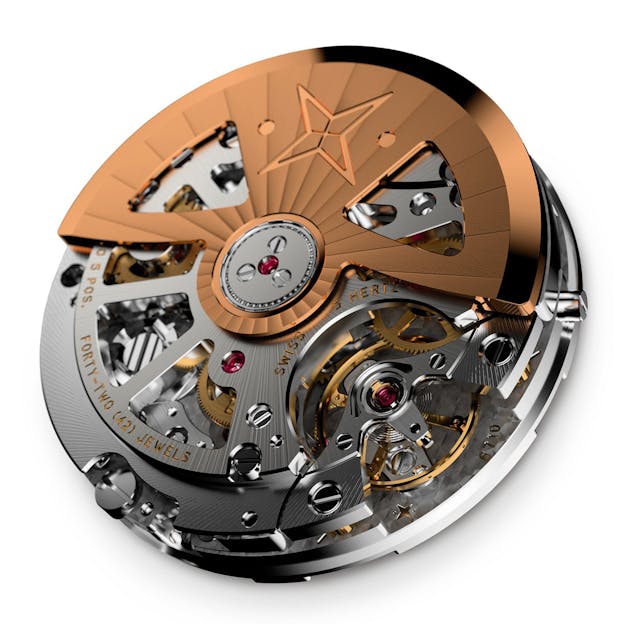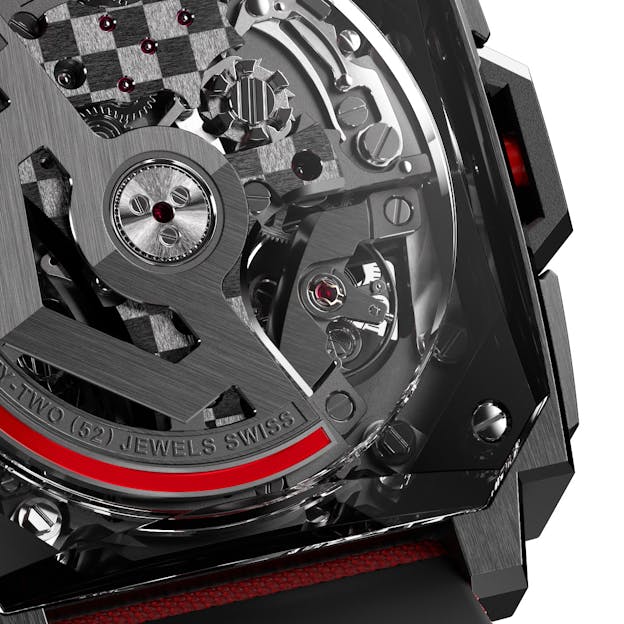The Road To A Rattrapante: The TAG Heuer Monaco Split Seconds
The new Monaco Split Seconds is the first split seconds wristwatch from TAG Heuer.
There were any number of surprises at Watches & Wonders this year – there always are, but this year given the general buzz that it would be an incremental year, there were many more than I’d expected. One new launch which was surprising for a couple of reasons, was TAG Heuer’s launch of the Monaco Split Seconds, an automatic rattrapante in a titanium Monaco case, which is TAG Heuer’s very first wristwatch rattrapante chronograph.

Given TAG Heuer’s long history as a specialist in chronographs and timers it’s something of a surprise to find that the company has never done a split seconds chronograph wristwatch before, because they’ve certainly produced split seconds stopwatches – Jeff Stein breaks down the history of the complication at Heuer at On The Dash, and in the story, Nick Biebuyck, Heritage Director at TAG Heuer, says that the reason Heuer didn’t go in for rattrapante wristwatches is simply because stopwatches are much easier to read, and Heuer’s expectation was that the complication would be most useful in the hand and at the track, than on the wrist.
Biebuyck says, “Heuer always sought to produce the most functional types of timepieces and the type of precision timekeeping that was required for racing, rallying and other sports required the larger dial of a pocket chronograph, rather than the smaller dial of a wristwatch. When you compare the ‘display’ that is possible with a 36 or even 40 millimeter wristwatch to what you get with a 52, 57 or even 65 millimeter pocket timer, there is an enormous difference. For reading 1/5 or 1/10s of seconds, or even full seconds, you need the larger display of the pocket timepiece.”

The point is a good one, and on top of the legibility issue there is the matter of expense. Split seconds chronographs historically have been difficult to construct and challenging to adjust properly – so much so that the complication is considered one of the classic Big Three high complications, along with the perpetual calendar and the minute repeater. The reason has to do not just with the complexity of the mechanism, but also the extreme precision necessary to make it work.
The split seconds chronograph lets you time two successive intervals, such as successive lap times at the track. There are two superimposed seconds hands, one on top of the other, so they look like a single hand. When you start the chronograph both hands start to run together. When the first car (for instance) crosses the line, you press the split button and the split seconds hand stops, recording the first lap time. When the second car crosses the line, you press the chronograph start/stop button, and the primary seconds hand stops, recording the second lap time. You can also leave the primary hand running and the split hand stopped, and then press the split button again, which releases the split hand to catch up, almost instantaneously, with the primary seconds hand.
The split seconds mechanism itself relies on a second column wheel, which controls a clamp that closes on the split seconds wheel in the movement when the split button’s pressed. This freezes the split hand in place. The wheel has a spring loaded roller mounted on a tiny lever, which rides around a return to zero heart cam on the primary seconds wheel. Releasing the split wheel by pushing the split button a second time, lets the pressure of the roller against the cam swing the split hand back to its synchronized position with the primary seconds hand.
All this means that the split seconds chronographs in their traditional form tend to be rare and fairly to very expensive (some of Patek Philippe’s most expensive and exclusive watches are rattrapante chronographs, to pick just one example). The complication was simplified by watchmaker Richard Habring, at IWC, with the Doppelchronograph, released originally in 1993; Habring would eventually start his own eponymous brand, where he still makes his version of the complication (the Doppel 38 which launched in 2022 at under $10,000, amazingly enough).

For its first split seconds chronograph, TAG Heuer chose the Monaco case – another possibility would of course have been to make a more formal version of the complication, in perhaps an Autavia case. The Monaco is a better platform for TAG’s first wristwatch split seconds chronograph, I think – although there’s nothing preventing TAG from using the complication in other models, though that seems unlikely for now. A split seconds Monaco ties the complication more directly into TAG Heuer’s history of track-oriented split seconds stopwatches – and of course, given the fact that the original Monaco was Heuer’s first automatic chronograph, it makes sense for the new Monaco Split Seconds to be automatic as well.

The design is an evolution of well known TAG Heuer design codes – the front and rear box crystals give the watch both a sense of substantial construction, and transparency and in particular, as seen from the back, the oscillating rotor seems to float above the rest of the movement.
For the movement, TAG Heuer worked with Manufacture Vaucher, the movement and complications supplier which is part of the same group as Parmigiani Fleurier (the group also includes technical suppliers like balance spring maker Atokalpa and casemaker Les Artisans Boîtiers). The base movement is the non-rattrapante Vaucher SEED WMF 6710, which Vaucher launched in 2018.
The 6710 for those interested in really granular detail, and you know who you are, was the subject of a Deconstruction and analysis at The Naked Watchmaker.

As far as I can tell, the movement has not been widely used. Parmigiani Fleurier has used an apparently related hand-wound rattrapante caliber, the PF 361, in the Tonda Chronor Anniversaire, in 2017 and again in the Tonda PF rattrapante, in 2022. The automatic version of the movement was used by Richard Mille, in the RM-35 01, launched in 2020, and I haven’t heard of the split seconds version of the movement surfacing anywhere else. It is perhaps not surprising that automatic rattrapante chronographs are so rare. The first automatic chronographs of any kind were not made until 1969, after all (Heuer was one of the first that year, with the Monaco) and the first self winding rattrapante movement did not appear until 1989, when F. Piguet released the caliber 1186; at the time, the thinnest automatic rattrapante in the world.

The movement as used by TAG Heuer, is extensively modified from the base caliber, although the TAG caliber TH81-00 shares the same 36,000 vph frequency as the RM-35-01, and the PF 361. Unlike the PF 361, which is a hand-wound movement with gold plates and bridges, the TH81-00 uses titanium plates and bridges, which it has in common with the RM-35-01. (The unmodified base caliber uses conventional rhodium plated brass for the plates and bridges). The use of titanium for the movement and case makes for a very lightweight watch, at about 85 grams (per TAG Heuer). The power reserve remains 65 hours, and the movement makes use of a one piece reset hammer and freesprung, adjustable mass balance.

This is of course, hardly the first complicated wristwatch timer from TAG Heuer. The Haute Horlogerie TAG Heuer watches include some of the most advanced timers ever made, generally with an emphasis on high frequency precision. This research culminated in the Mikrogirder, launched in 2012, which had a linear, two part “beam” oscillator for the chronograph, and which vibrated at 7,200,000 vph, or two thousand beats per second, which I think is probably the practical limit for a chronograph oscillator – or at least no one else has taken a shot at the record since.
Although the Monaco Split Seconds will be a series produced watch, production numbers will probably be low for the foreseeable future and the price – CHF 135,000 – will help keep it exclusive as well (for comparison, the RM-65 01 was priced at CHF 270,000 at launch). As a first of its kind from TAG Heuer, as well as a stylishly idiosyncratic vehicle for one of a very small number of automatic rattrapante chronograph movements, the Monaco Split Seconds is getting a lot of well deserved attention, and raises some interesting questions about the future of high complications at TAG Heuer – as does the presence of Carole Forestier-Kasapi as TAG Heuer’s movement director.

She’s a legend in her own right – behind everything from many of the Richemont Groups tourbillons, to the design that would become the Ulysse Nardin Freak, to all of the exotic high complications Cartier made once upon a time as part of their Fine Watchmaking Collection. I don’t know what her brief is exactly – she joined TAG Heuer in 2020, after fifteen years at Cartier – and the appetite in the industry for exotic and expensive high complications which innovate technically is perhaps less keen than it was in the mid-2000s. Still, you don’t hire General Patton to run logistics for the mess hall; I’m curious to see what comes next.
The TAG Heuer Monaco Split Seconds: 2 versions, one with red accents and black movement arches; one with blue accents and blue movement arches. Case for the red model, black DLC coated titanium, black DLC coated pushers and crown; blue model, brushed and polished titanium case, pushers, and crown. Both: cases 41mm square, 47.9mm lug to lug, 15.2mm thick, with beveled sapphire crystals front and back; water resistance 30 meters. Movement, caliber TH81-00, collaboration with Manufacture Vaucher; 36,000 vph, rattrapante automatic chronograph, with 65 hour power reserve (55 hours with the chronograph running). Double column wheel, lateral clutch with freesprung balance under balance bridge. Price, CHF 135,000, available in June. For more, visit TAGHeuer.com.

